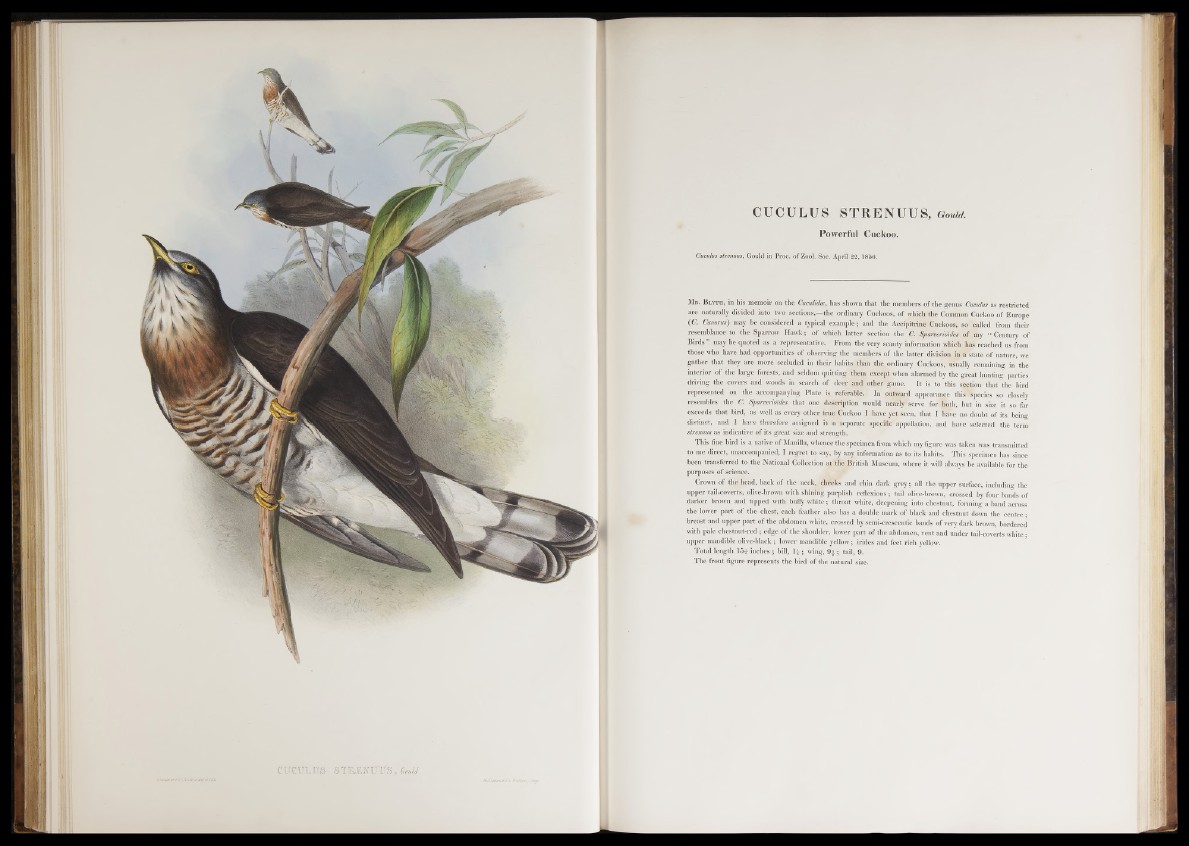
: FO IL UTS STKJENiniSft GouU.
CUCULUS STRENUUS, Gould.
Powerful Cuckoo.
Cuculus stremms, Gould in Proc. o f Zool. Soc. April 22, 1856.
M r . B l y th , in his memoir on the Cuculidce, has shown that the members o f the genus Cuculus as restricted
are naturally divided into two sections,—the ordinary Cuckoos, o f which the Common Cuckoo o f Europe
(C. Canorus) may be considered a typical example; and the Accipitrine Cuckoos, so called from their
resemblance to the Sparrow Hawk; o f which latter section the C. Sparvermdes of my “ Century of
Birds” may be quoted as a representative. From the very scanty information which has reached us from
those who have had opportunities of observing the members of the latter division misstate of nature, we
gather that they are more secluded in their habits than the.ordinary Cuckoos, usually remaining in the
interior of the large forests, and seldom quitting them except when alarmed by the great hunting parties
driving the covers and woods in search o f deer and other game. It is to this section that the bird
represented on the accompanying Plate is referable. In outward appearance thi^lpecies so closely
resembles the C. Sparverioides that one description would nearly’ serve for both, but in size it so far
exceeds that bird, as well as every other true. Cuckoo I have yet seen, that I hive no doubt o f its being
distinct, and I have therefore assigned it a separate specific appellation, and have selected the term
strenuus as indicative of its great size and strength.
This fine bird is a native of Manilla, whence the specimen from which my figure was taken was transmitted
to me direct, unaccompanied, I regret to say, by any information as to its habits. This specimen has since
been transferred to the National Collection-at the British Museum, where it will always be available for the
purposes of science.
Crown o f the head, back of the necfc checks and chin dark grey; all the upper surface, including the
upper tail-coverts, olive-brown with shining purplish reflexions; tail olive-brown, crossed by four bands of
darker brown and tipped with bully white ; throat white, deepening into chestnut, forming .a band across
the lower part of the chest, each feather also has a double mark of black and chestnut down the centre;
breast and upper part of the abdomen white, crossed by semi-crescentic bands of very dark brown, bordered
with pale chestnut-red; edge of the shoulder, lower part of the abdomen, vent: and under tail-coverts white •
upper mandible olive-black ; lower mandible yellow; iri'des and feet rich yellow.
Total length 15-1 inches ; bill, If-; wing, 9 f ; tail, 9.
The front figure represents the bird of the natural size.